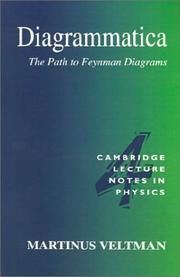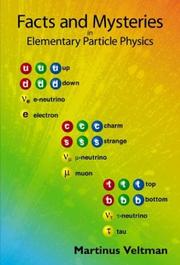| Listing 1 - 10 of 22 | << page >> |
Sort by
|

ISBN: 0521456924 Year: 1994 Volume: 4 Publisher: Cambridge Cambridge University press
Abstract | Keywords | Export | Availability | Bookmark
 Loading...
Loading...Choose an application
- Reference Manager
- EndNote
- RefWorks (Direct export to RefWorks)
This author provides an easily accessible introduction to quantum field theory via Feynman rules and calculations in particle physics. His aim is to make clear what the physical foundations of present-day field theory are, to clarify the physical content of Feynman rules. The book begins with a brief review of some aspects of Einstein's theory of relativity that are of particular importance for field theory, before going on to consider the relativistic quantum mechanics of free particles, interacting fields, and particles with spin. The techniques learnt in the chapters are then demonstrated in examples that might be encountered in real accelerator physics. Further chapters contain discussions of renormalization, massive and massless vector fields and unitarity. A final chapter presents concluding arguments concerning quantum electrodynamics. The book includes valuable appendices that review some essential mathematics, including complex spaces, matrices, the CBH equation, traces and dimensional regularization. An appendix containing a comprehensive summary of the rules and conventions used is followed by an appendix specifying the full Lagrangian of the Standard Model and the corresponding Feynman rules. To make the book useful for a wide audience a final appendix provides a discussion of the metric used, and an easy-to-use dictionary connecting equations written with different metrics. Written as a textbook, many diagrams, exercises and examples are included. This book will be used by beginning graduate students taking courses in particle physics or quantum field theory, as well as by researchers as a source and reference book on Feynman diagrams and rules.
Quantum mechanics. Quantumfield theory --- Feynman diagrams --- Physics --- 530.19 --- Many-body problem --- Matrices --- Quantum theory --- 530.19 Fundamental functions in general. Potential. Gradient. Intensity. Capacity etc. --- Fundamental functions in general. Potential. Gradient. Intensity. Capacity etc. --- Fundamental functions in general. Potential. Gradient. Intensity. Capacity etc --- Feynman diagrams. --- Physics.

ISBN: 113924339X 1139930273 1139931725 113992950X 1139933728 1139936921 1139939238 0511564074 9781139939232 9780511564079 0521456924 9780521456920 Year: 1994 Publisher: Cambridge
Abstract | Keywords | Export | Availability | Bookmark
 Loading...
Loading...Choose an application
- Reference Manager
- EndNote
- RefWorks (Direct export to RefWorks)
This author provides an easily accessible introduction to quantum field theory via Feynman rules and calculations in particle physics. His aim is to make clear what the physical foundations of present-day field theory are, to clarify the physical content of Feynman rules. The book begins with a brief review of some aspects of Einstein's theory of relativity that are of particular importance for field theory, before going on to consider the relativistic quantum mechanics of free particles, interacting fields, and particles with spin. The techniques learnt in the chapters are then demonstrated in examples that might be encountered in real accelerator physics. Further chapters contain discussions of renormalization, massive and massless vector fields and unitarity. A final chapter presents concluding arguments concerning quantum electrodynamics. The book includes valuable appendices that review some essential mathematics, including complex spaces, matrices, the CBH equation, traces and dimensional regularization. An appendix containing a comprehensive summary of the rules and conventions used is followed by an appendix specifying the full Lagrangian of the Standard Model and the corresponding Feynman rules. To make the book useful for a wide audience a final appendix provides a discussion of the metric used, and an easy-to-use dictionary connecting equations written with different metrics. Written as a textbook, many diagrams, exercises and examples are included. This book will be used by beginning graduate students taking courses in particle physics or quantum field theory, as well as by researchers as a source and reference book on Feynman diagrams and rules.
Feynman diagrams. --- Quantum theory. --- Quantum dynamics --- Quantum mechanics --- Quantum physics --- Physics --- Mechanics --- Thermodynamics --- Many-body problem --- Matrices --- Quantum theory --- Feynman diagrams

ISBN: 1281872563 9786611872564 9812563024 9789812563026 9812381481 981238149X 9789812381484 9789812381491 9781281872562 6611872566 Year: 2003 Publisher: River Edge, NJ World Scientific Pub.
Abstract | Keywords | Export | Availability | Bookmark
 Loading...
Loading...Choose an application
- Reference Manager
- EndNote
- RefWorks (Direct export to RefWorks)
A comprehensive overview of modern particle physics, which seeks to be accessible to anyone who wants to know how the universe works. An explanation of quantum mechanics and relativity paves the way for an understanding of the laws that govern particle physics.
Particles (Nuclear physics) --- Elementary particles (Physics) --- High energy physics --- Nuclear particles --- Nucleons --- Nuclear physics
Book
ISBN: 9789076988443 Year: 2003 Publisher: Amsterdam Natuurwetenschap & Techniek
Abstract | Keywords | Export | Availability | Bookmark
 Loading...
Loading...Choose an application
- Reference Manager
- EndNote
- RefWorks (Direct export to RefWorks)
Book
Year: 1967 Publisher: Amsterdam Noord-Hollandsche Uitgevers-Maatschappij
Abstract | Keywords | Export | Availability | Bookmark
 Loading...
Loading...Choose an application
- Reference Manager
- EndNote
- RefWorks (Direct export to RefWorks)
Book
Year: 1963 Publisher: Place of publication unknown publisher unknown
Abstract | Keywords | Export | Availability | Bookmark
 Loading...
Loading...Choose an application
- Reference Manager
- EndNote
- RefWorks (Direct export to RefWorks)

ISBN: 9812381481 981238149X 987238149X 9789812381491 9789812381484 Year: 2003 Publisher: New Jersey : World Scientific,
Abstract | Keywords | Export | Availability | Bookmark
 Loading...
Loading...Choose an application
- Reference Manager
- EndNote
- RefWorks (Direct export to RefWorks)
This book provides a comprehensive overview of modern particle physics accessible to anyone with a true passion for wanting to know how the universe works. We are introduced to the known particles of the world we live in. An elegant explanation of quantum mechanics and relativity paves the way for an understanding of the laws that govern particle physics. These laws are put into action in the world of accelerators, colliders and detectors found at institutions such as CERN and Fermilab that are in the forefront of technical innovation. Real world and theory meet using Feynman diagrams to solve the problems of infinities and deduce the need for the Higgs boson.
Particles (Nuclear physics) --- Particles (Nuclear physics). --- Particules (physique nucléaire) --- History of physics --- Elementary particles --- 539.1 --- Elementary particles (Physics) --- High energy physics --- Nuclear particles --- Nucleons --- Nuclear physics --- 539.1 Nuclear physics. Atomic physics. Molecular physics --- Nuclear physics. Atomic physics. Molecular physics --- Particules (Physique nucléaire) --- Monograph --- Particules (physique nucléaire)
Book
Year: 1956 Publisher: Amsterdam De Beuk
Abstract | Keywords | Export | Availability | Bookmark
 Loading...
Loading...Choose an application
- Reference Manager
- EndNote
- RefWorks (Direct export to RefWorks)
Book
Year: 1984 Publisher: Amsterdam Athenaeum-Polak en Van Gennep
Abstract | Keywords | Export | Availability | Bookmark
 Loading...
Loading...Choose an application
- Reference Manager
- EndNote
- RefWorks (Direct export to RefWorks)
Book
ISBN: 9789813237056 9789813237490 9789813237070 Year: 2018 Publisher: New Jersey : World Scientific,
Abstract | Keywords | Export | Availability | Bookmark
 Loading...
Loading...Choose an application
- Reference Manager
- EndNote
- RefWorks (Direct export to RefWorks)
This book provides a comprehensive overview of modern particle physics accessible to anyone with a true passion for wanting to know how the universe works. We are introduced to the known particles of the world we live in. An elegant explanation of quantum mechanics and relativity paves the way for an understanding of the laws that govern particle physics. These laws are put into action in the world of accelerators, colliders and detectors found at institutions such as CERN and Fermilab that are in the forefront of technical innovation. Real world and theory meet using Feynman diagrams to solve the problems of infinities and deduce the need for the Higgs boson. Facts and Mysteries in Elementary Particle Physics offers an incredible insight from an eyewitness and participant in some of the greatest discoveries in 20th century science. From Einstein's theory of relativity to the spectacular discovery of the Higgs particle, this book will fascinate and educate anyone interested in the world of quarks, leptons and gauge theories. This book also contains many thumbnail sketches of particle physics personalities, including contemporaries as seen through the eyes of the author. Illustrated with pictures, these candid sketches present rare, perceptive views of the characters that populate the field. The Chapter on Particle Theory, in a pre-publication, was termed "superbly lucid" by David Miller in Nature (Vol. 396, 17 Dec. 1998, p. 642).
| Listing 1 - 10 of 22 | << page >> |
Sort by
|

 Search
Search Feedback
Feedback About UniCat
About UniCat  Help
Help News
News